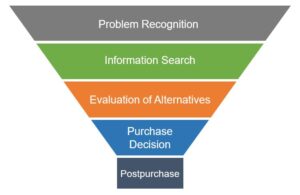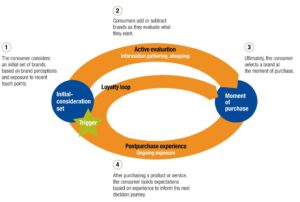The internet has transformed many aspects of life over the last three decades. Individuals in the United States and across the globe now use computers or mobile devices to communicate with friends, family, and strangers; look for information; purchase products; and perform a host of other everyday activities.
In 1990, for example, less than 1 percent of the U.S. population was online. By 2015, this percentage had increased to 75 percent and by 2019 the overwhelming majority, nearly 90 percent, of American adults used the internet. Americans also increased the time they spent online, from a weekly average of 9.4 hours in 2000 to 23.6 hours in 2016. In 2018, more than three-fourths (77 percent) of Americans were online on a daily basis.
The Purchase Funnel
Unsurprisingly, the internet has fundamentally altered the consumer decision-making process. This shift has led many marketing professionals to rethink the foundational framework that has been widely used to conceptualize consumer purchasing behavior for many decades. Specifically, since the early 1900s, marketing experts have used the “purchase funnel” to describe the stages that consumers pass through to buy products and services.

Generally, the stages of the purchase funnel are as follows:
- Problem recognition: Consumers identify a need and seek a product to fill that need.
- Information search: Using various sources of information, consumers research products that might satisfy their need.
- Evaluation of alternatives: Consumers evaluate brands they are considering and decide on the brand they intend to purchase.
- Purchase decision: Consumers may adjust their intentions based on a host of situational factors; ultimately, they execute a purchase.
- Postpurchase: Consumers’ satisfaction with the product affects whether they will buy it again in the future.1
Traditionally, this process has been described as a funnel because consumers were assumed to proceed down a linear path that started with many brands and products that might fulfill their need (at the broad top of the funnel). As they move closer to purchase, consumers sequentially decrease the number of products they might buy until, ultimately, they make a final decision (at the narrow bottom of the funnel).2
While this kind of thinking can have merit, the growth of the internet in everyday life has dramatically changed the way consumers make purchasing decisions.3 For example, before the internet became ubiquitous, most consumers did not have access to hundreds of product reviews or search engines to price shop, and had only a handful of local retail establishments for many goods.
The Decision Journey
To account for this increasing complexity, marketing scholars and practitioners have reimagined the purchase funnel. Now, many marketing professionals use the framework of a “decision journey” to describe consumers’ decision-making processes.4 Consumers on a decision journey are not assumed to sequentially eliminate brands and products that may satisfy their needs; instead, consumers go through cycles in which some products that they initially considered may be eliminated, but other products may be added to the consideration set even if consumers did not consider these products initially:5

Given the shift in consumer purchasing behavior, marketing practitioners have had to adjust their traditional thinking and adapt to the new options that consumers have for shopping. One of the most critical aspects of this is acknowledging who controls the marketing message.
Previously, marketers were in charge of the process, exerting more control over both the message itself and how it was received by consumers. Today, consumers have more control regarding the messages they hear and the means to receive them. For example, today’s consumers have the ability to receive information and insights from other consumers, and they may rely heavily on online reviews and other electronic word-of-mouth (sometimes called “eWOM”).
Furthermore, the emergence of search engines has resulted in dramatic differences in how consumers actively search for information and make purchase decisions. These new ways of obtaining information limit the effectiveness of “one size fits all” marketing messages. Consumers now play the lead role because they have the ability to “pull” information, reducing the marketer’s ability to “push” information.
The development of the decision journey framework has also contributed to the understanding that the journey for a given consumer for the same good can vary from situation to situation. And, of course, the journey for one consumer who purchases a product can be very different from the journey taken by another consumer who purchases the exact same product.
An Example of the Decision Journey for an Automobile
An example can illustrate the complexities of decision-making under the decision journey framework as compared to the purchase funnel framework. Imagine Chris, a consumer in today’s market searching for a vehicle. On the journey towards an automobile purchase, Chris initially considers a set of vehicles comprising those she has previously owned and had positive experiences with. However, instead of restricting her consideration set to known options, Chris begins to research other vehicles. For example, Chris may email dealers who display their inventories online for more information, or she may read one of many third-party review websites. Chris may also search social media sites and glean information from both her own friends and family and strangers whose experiences she finds instructive.
Through this research process, the number of options in Chris’s consideration set may increase, decrease, or stay the same. When it comes time to select a specific vehicle, Chris may go with a dealer she previously identified online, or visit one or many in person. After these interactions, which may also increase or decrease the number of vehicles being considered, Chris may conduct further real-time research on her smartphone to compare features and prices. She might also navigate to websites that advertise rates for car loans instead of being limited to the dealership’s finance department—some of these websites may point her to yet more vehicles. After completing her purchase, Chris may continue to conduct research on her vehicle by visiting general or model-specific enthusiast websites. Thus, the winding journey that led Chris to her ultimate purchase was affected by many complex factors and, in fact, continued after the actual purchase.
Implications for Litigation
The consumer decision journey framework has many important implications for litigation. For example, it is important to consider the various types of information sources that consumers are exposed to and whether and to what extent this information affects an individual’s purchase decision. Furthermore, one can analyze the relative importance of manufacturer advertising or specific advertising claims as compared to content generated by consumers themselves. Finally, experts should carefully examine the appropriateness of analytical methods that may not allow for the richness of the products and brands that consumers may consider at various stages of the consumer decision journey.
The views expressed herein do not necessarily represent the views of Cornerstone Research.
1 P. Kotler and K. Keller, Marketing Management, 14th ed. (Prentice Hall, 2012), 172–180.
2 Kotler and Keller (2012), 172–180; D. Court et al., “The Consumer Decision Journey,” McKinsey & Company, June 1, 2009, https://www.mckinsey.com/business-functions/marketing-and-sales/our-insights/the-consumer-decision-journey (“McKinsey Consumer Journey”).
3 “The Evolution of Consumer Behavior in the Digital Age,” Medium, November 16, 2017, https://medium.com/analytics-for-humans/the-evolution-of-consumer-behavior-in-the-digital-age-917a93c15888; McKinsey Consumer Journey.
4 McKinsey Consumer Journey; R. Divol, D. Edelman, and H. Sarrazin, “Demystifying Social Media,” McKinsey Quarterly, April 1, 2012, https://www.mckinsey.com/business-functions/marketing-and-sales/our-insights/demystifying-social-media.
5 Chart reproduced from McKinsey Consumer Journey, Exhibit 2.